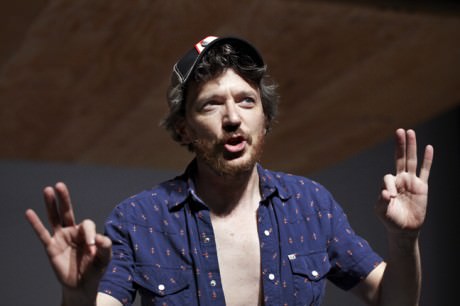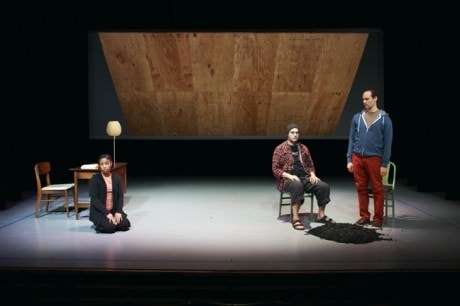Zero Cost House is billed as playwright Toshiki Okada’s autobiography but, like Walden, Thoreau’s book that is quoted extensively in the play, this is more of a travelogue through the creative process of writing this play. Yes, this play is about writing this play, and twisting your brain around that is just the first step to entering Okada’s world.

Toshiki Okada usually choreographs and directs his own work with his theater company Chelfitsch (a mash-up of the words childish taste and selfish), but he has left them home for this foray. He penned this work in collaboration with the Pig Iron Theater Company, a 16-year-old troupe based in Philadelphia that calls itself a “dance-clown-theatre ensemble.” It is a departure for Pig Iron as well, who usually create ensemble, “interdisciplinary performances” in varying styles, using things like masks and pure physicality to tell stories. They say they do “devised” theater where traditional roles like playwright or director or actor are entirely beside the point. Not this time. This time the playwright is the point.
Okada is well-known on the international scene and has been causing havoc and wild applause with his works in Japan and Europe, but this is his first English-language world premier. (His play Enjoy was voted the worst play of the year in Japan, only to become a New York hit a year later). The play was translated by his usual translating partner, Aya Ogawa, a playwright in her own right.
Various creative works over the centuries have attempted to explore the creative process, but I have never seen it done more honestly. Okada get this exactly right, but like laws and sausages, I am not certain we really want to see just how plays are made.
In the program, it talks about 3/11 (a day as important in Japan as 9/11 is in the United States; it’s when the Tsunami hit), but it also talks about the “Zero Yen House” movement in Japan where people are living off the grid, and talks about Walden. These themes tie together only as the soup of inspiration Okada pulls from for this play…about that soup of inspiration, and unlike a finished play that we don’t get to see what has inspired it, in this one, every random flash is onstage and Okada makes little effort – except by the most tentative links – to connect them.
The play begins with himself in monologue with himself of 15 years ago, writing, reading Walden, and wondering if he was better off or if he’s turned arrogant in his success. Arrogance and confidence remain one of the steadfast themes as Thoreau himself puts in a few appearances. As the play proceeds, the zero cost houses take greater prominence in the form of Okada’s charismatic, crazy friend who wrote the book on them, Kyohei Sakaguchi. Around Act 3, when the partnership with this American theater company is full swing, the tsunami hits, and we are left with the survivors’ take.

Throughout it all, one (young or old) Okada is writing at his desk and occasionally actors, dressed as rabbits, act out his words as he writes them. Like a play in progress, some times they are Irish, sometimes they are Japanese, and sometimes they refer to the fact that they are giant bunnies and sometimes not… His manager also makes an appearance, questioning his genius and his sanity as the play goes on. Also like every creative work in progress, there are random acts of randomness, like an actor rolling across the stage, ignored by the others or the song by the rabbits that starts act 2, passing without comment by Okada for once.
The 5 actors in the company, Mary McCool, Shavon Norris, James Sugg, Alex Torra, and Dito van Reigersberg switch roles at every scene, playing Thoreau or one of the Okadas, his manager, Kyohei, or the rabbit-people. They are all talented actors and embrace this disjointed style, and, since much of the play is in monologue to the audience and the houselights stay up the entire time, they seem to have fun breaking the fourth wall and watching our faces and playing directly to us as much as we watch them. Everyone is also very good at the details of each role, adjusting their performance to match each other and contrast with their role the scene before.
Director Dan Rothenberg has a hand in steering that process successfully as well. He seems to understand Okada and keeps the actors moving around the stage in and out of the dreamlike sequences easily. He keeps things interesting and the energy up as the play keeps taking right turns on itself and I liked the no-nonsense style he brought to it. Yes, they are rabbits. Yes, Okada is talking to himself talking to Thoreau who at one point talks to his imaginary bunnies, but that’s creating for you.
The set design by Mimi Lien was simple and modern, but a wall of large pieces of plywood slowly lifted into the air without explanation and proved somehow menacing by the end looming over the stage, and a pile of dirt proves addicting to the actors as they keep returning to it amidst their other furniture. Maiko Matsushima’s costumes follow the same vein. Everyone is wearing contemporary clothes and then there are those bunnies. But I appreciated her little touches, like her imagining of Thoreau today, in flip-flops, a plaid shirt, and a knit hat.
I found myself wondering how Okada was going to wrap this up since the process was the point. But end it does, and the end is perfect and poetic. He mentions with derision throughout the play that one critic called him “a talent of the decade” – and I don’t know about that – but as every level of philosophical musing, random rabbit wearing character and endless monologue came together, I could see why it was said. It turns out, none of it was random. Each scene, each word was leading to the final line and, – I’ll use poetic again – I have never seen a more poetic moment.
I couldn’t wait for it to end and then didn’t want it to, and have been grinning the whole time writing this review. Zero Cost House is an amazing piece. Plays like this are exactly why I love DC theater: it’s just this 2-day production at Georgetown of this incredible play by this world-famous playwright and acclaimed performance group.

Running Time: Approximately two hours with no intermission.
Zero Cost House plays through September 29, 2012 at the Georgetown University’s 108 Davis Performing Arts Center – 3700 O St., NW, IN Washington, D.C. For tickets, call (202) 687-3838, or purchase them online




